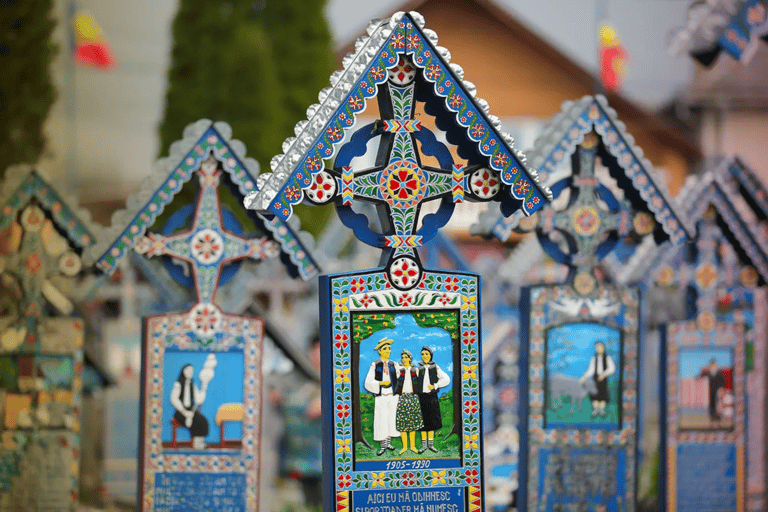Exploring Romania's Death Culture: Unique Traditions and Rituals
Discover Romania's deep-rooted death traditions, from ancient superstitions to modern funeral practices, in this fascinating look at how Romanians honor life and the afterlife.
10/14/20244 min read


Romanian Death Culture: Traditions, Superstitions, and Modern Practices
Romanian culture is rich, complex, and filled with fascinating customs that reflect both its ancient roots and its evolving modern identity. One area where this is especially clear is in their approach to death and dying. In this blog post, we will explore some of the unique traditions and beliefs surrounding death in Romania, from superstitions to burial rituals, and how modern changes are influencing the way Romanians approach the end of life.
Romania: A Quick Overview
Romania, located in Eastern Europe, has a population of just over 19 million people. Its capital, Bucharest, is a bustling city, but much of Romania’s population lives in more rural settings where traditions are still strongly adhered to. Romania is also a very religious country, with about 85% of the population identifying as Christian, the majority of whom follow the Romanian Orthodox Church. This religious influence is deeply intertwined with folk traditions, making for a unique cultural landscape when it comes to death rituals.
Aging and Dying in Romania
In Romanian culture, family is everything, especially when it comes to caring for the elderly. Elders are highly respected, and it is common for them to live with their families until the end of their lives. Unlike many Western countries, the idea of placing an elderly family member in a nursing home is still seen as deeply disrespectful in Romania.
However, modern hospice care has begun to make its mark. Since 1992, Romania has seen the development of non-profit palliative care services. Over time, medical education has incorporated palliative care into nursing and medical school curriculums, making it more accessible. Still, as more young Romanians leave the country for work abroad, balancing these traditional family roles with modern care systems is becoming increasingly difficult.
Romanian Superstitions Surrounding Death
Death in Romanian culture is often associated with a number of superstitions that have been passed down through generations. Some of the more common beliefs include:
A mirror or furniture breaking is seen as a sign of impending death.
Dogs howling with their heads down, especially outside a sick person’s home, is another ominous sign.
Owls, seen as symbols of death, are also believed to foretell a person’s passing if they hoot nearby.
A person close to death may begin staring at their nails or the wall, which is interpreted as a sign of their impending departure.
These superstitions are taken seriously in many rural parts of Romania, where folk traditions and religion still guide many aspects of life and death.
Deathbed Rituals and the Journey to the Afterlife
When someone is close to death in Romania, certain rituals are followed to ensure their safe passage into the afterlife. A candle is placed at the head of the dying person to help them "see" their way to the afterlife. A priest is called to perform the Sacrament of the Holy Unction, also known as the Anointing of the Sick.
After death, mirrors in the home are covered with black cloth to prevent the spirit from becoming trapped in them, which could lead to hauntings. Doors in the house are also left unlocked so the spirit can easily leave. Even animals are kept away to prevent the spirit from entering their bodies.
Watch Our Full Video
Funeral Traditions: Food, Funerals, and Final Farewells
Once a person has passed, their family hosts a wake that typically lasts two nights. During the day, the deceased is watched over, and the nights are spent celebrating their life with parties. These celebrations often include traditional Romanian foods such as kolach (a sweet bread) and coliva (a dish made from wheat grains to represent the deceased’s sins). Food is an important part of Romanian death culture, symbolizing both life and the passage to the next world.
During the funeral itself, it’s important that the deceased enter the church first. Mourners are usually given candles and handkerchiefs as a sign of respect. Male mourners may even receive these items as a “homage,” which they are expected to keep after the service. While modern Romanian funerals are often somber, in decades past, some areas included professional mourners who wailed at the coffin, and even celebratory music and dancing.
Burial Practices and Cremation
Before burial, the deceased may have their clothing changed. Elderly people often choose their burial clothes ahead of time, while young, unmarried individuals are dressed in wedding attire for their funerals. Infants are believed to become angels, so their clothing is altered to represent this.
Most Romanians follow the Orthodox tradition of burial, and although cremation is legal, it remains rare, with only two cremation facilities in the country located in Bucharest and Oradea.
Cultural Etiquette and Beliefs Around Death
If you’re ever invited to a Romanian funeral, there are a few important etiquette tips to keep in mind. First, never wear red—this is considered extremely disrespectful to the deceased. Also, always bring an even number of flowers, as an odd number is associated with celebrations rather than mourning.
The Real Dracula
When many of us think of Romania, we immediately think of Dracula. However, the real Dracula, Vlad III, known as Vlad the Impaler, was a historical figure, not a vampire. Vlad is remembered for his brutal tactics in warfare, but the myth of the vampire only developed later.
While Romania may be associated with vampires in pop culture, the reality is that these myths stem from much deeper folk beliefs about death and the afterlife. As we mentioned earlier, the fear of a restless spirit is real enough that exhumations can still take place if people believe a deceased person hasn’t been properly laid to rest. Though rare today, these practices echo the ancient fears of the dead returning to disturb the living.
The Merry Cemetery of Săpânţa
One of the most fascinating cemeteries in Romania is the Merry Cemetery of Săpânţa. Unlike the somber atmosphere of most burial grounds, this cemetery features brightly painted tombstones that tell the stories of the people buried there—sometimes in humorous or irreverent ways. Limericks and illustrations depict everything from personal vices to funny accidents, bringing a unique sense of levity to the afterlife.
Conclusion
Romanian death culture is a deeply fascinating blend of Orthodox Christianity, ancient folklore, and unique local traditions. From the superstitions that surround death to the intricate funeral customs, Romanians have preserved many aspects of their history even as the world around them has changed. Their approach to death is both reverent and celebratory, reflecting a belief in the importance of helping loved ones transition peacefully into the afterlife.
Ready to Dive Deeper? Book a 1-Hour Virtual Consultation Today!



